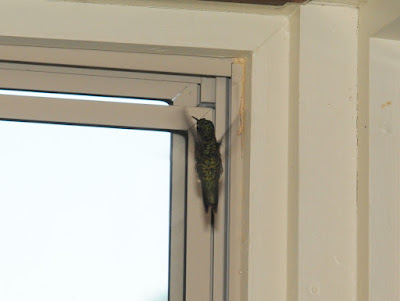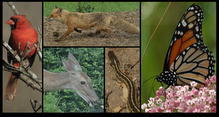Middleton Spider
Update: LB advises that this is a Golden Silk Orb-Weaver.
Wildlife observations from a suburban backyard adjacent to the Colvin Run Mill Park in Vienna, Virginia. Click on photos to enlarge.
Posted by
Gil Miller
at
6:20 PM
1 comments
![]()
Labels: 2008 Summer, On the Road, Spider
Posted by
Gil Miller
at
6:19 PM
0
comments
![]()
Labels: 2008 Summer, Eastern Gray Squirrel

Posted by
Gil Miller
at
6:18 PM
0
comments
![]()
Labels: 2008 Summer, On the Road, Osprey
Posted by
Gil Miller
at
6:17 PM
0
comments
![]()
Labels: 2008 Summer, Butterfly, On the Road, Pickering Creek

Posted by
Gil Miller
at
6:16 PM
0
comments
![]()
Labels: 2008 Summer, Lesser Yellowlegs, Pickering Creek, Short-billed Dowitcher, tilt Sandpiper
Posted by
Gil Miller
at
6:15 PM
0
comments
![]()
Labels: 2008 Summer, Hummingbird
One day, I decided to attempt some close-ups of the hummingbirds feeding near the window. To get the best photo, I opened the window to the porch. After about five minutes and lots of photos, I took up another position - forgetting to close the window.
As the more aggressive hummer returned, he bumped another one into the open window. We had a hummingbird in the house. The in-house hummer immediately went to the highest level (the ceiling) and had no way to get out. For the next 15 minutes, I struggled with how to get the hummer out, while the hummer struggled with exhaustion. During one point the hummer took a rest in one of my wife's summer wreaths hanging on the wall.
Posted by
Gil Miller
at
6:00 PM
0
comments
![]()
Labels: 2008 Summer, Hummingbird

Posted by
Gil Miller
at
3:30 PM
0
comments
![]()
Labels: 2008 Summer
Posted by
Gil Miller
at
3:19 PM
0
comments
![]()
Labels: 2008 Summer, Hummingbird
We began the second day of our Christmas road trip from the Colvin Run Habitat to Frisco, Texas, by leaving
A good number were hawks that we are familiar with - red-tails, red-shoulders, even a few sharp-shinned hawks. On three occasions, we observed red-tails swooping down from a post or tree to grab a small rodent. On two of these observations, the red-tail was parallel to the line of our travel. On one of these observations though, the hawk came right to left across the road to grab something on a very wide median - no problem as the hawk was well in front of us. However, after picking up the prey, the hawk made a U-turn and came back across the road. At that point, I had to swerve the car to avoid taking out the hawk with my windshield.
There were several hawks observed that are not frequently seen in the Habitat or on the East Coast. I believe that on two occasions, we believe we observed Golden Eagles. Even though we had observed several red-tailed hawks of considerable size, the size of these golden eagles was remarkable. Their all brown exteriors was in stark contrast to the white, white/brown, or reddish brown breasts of the other perched raptors. A quick bit of research showed that while the golden eagles do not nest in Arkansas, they do winter in Arkansas. We hope we got the observation correct.
Posted by
Gil Miller
at
3:18 PM
0
comments
![]()
Labels: Golden Eagle, On the Road, Red-Shouldered Hawk, Red-tailed Hawk, Sharp-shinned Hawk

Posted by
Gil Miller
at
3:00 PM
0
comments
![]()
Labels: 2008 Summer, On the Road, Peacock



Posted by
Gil Miller
at
11:19 AM
0
comments
![]()
Labels: 2008 Summer, White-tailed Deer




Posted by
Gil Miller
at
11:55 AM
0
comments
![]()
Labels: 2008 Summer, Fawns, White-tailed Deer
This work is licensed under a Creative Commons Attribution-NonCommercial 3.0 License.
